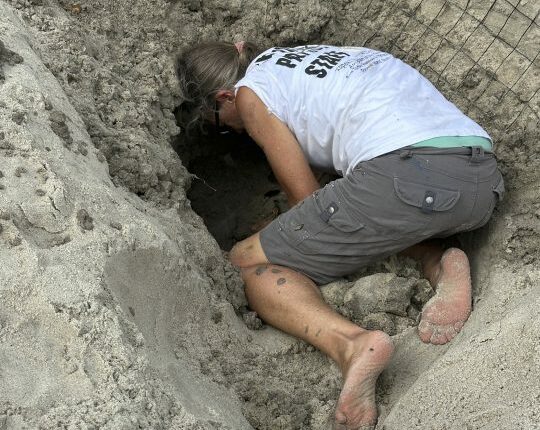Share this @internewscast.com

As Hurricane Erin battered North Carolina’s barrier islands with fierce winds and waves this week, it decimated numerous nests of endangered sea turtles, either submerging the eggs under sand or sweeping them into the ocean.
On Topsail Island, the storm eradicated more than half of the 43 loggerhead turtle nests, reported Terry Meyer, conservation director for the Karen Beasley Sea Turtle Rescue and Rehabilitation Center.
“I didn’t expect the water level to be so elevated, with the eggs practically sitting in water when we reached them,” she stated. “I don’t think I’ve witnessed such extensive flooding before.”
Although Erin never made landfall and didn’t cause extensive damage to infrastructure despite being double the size of a typical hurricane, the turtles weren’t as fortunate.
Loggerheads, identifiable by their large head and powerful jaw muscles, are threatened in the U.S. largely due to fishing bycatch, according to the National Oceanic and Atmospheric Administration. They primarily nest in the state every two to three years from May to August, with roughly 100 eggs per nest.
Meyer mentioned that on a broader scale, the loss of several nests won’t significantly affect the species. However, for the numerous volunteers dedicated to monitoring each nest across the 26-mile (42-kilometer) beach every summer, the loss is deeply saddening.
“When you’re digging up a nest that’s got 100 dead, fully developed, ready-to-go hatchlings — I’m old and jaded, but that can be pretty tough to handle,” she said.
About 33 miles (53 kilometers) to the northeast, the storm likely wiped out eight of the 10 remaining loggerhead turtle nests on Emerald Isle, said Dale Baquer, program coordinator and president of the Emerald Isle Sea Turtle Patrol.
One survived when the turtles managed to hatch Wednesday night, while another one likely made it safely through the storm because of its higher location on the dunes, according to Baquer. But there is little chance for the others, though it will not be known for sure until about 75 days into the incubation cycle.
“They really suffered a lot of damage. A lot of high tides and a lot of sitting water. But we’re just going to remain optimistic,” she said.
Both organizations tried to get ahead of the storm by picking up signs or extra stakes or fencing that could be washed out or cause other problems for the turtles.
But there is little they can do given North Carolina’s strict laws about keeping the sea turtle hatching process natural.
Baquer said the only time the group can obtain state permission to help a nest is if it knows it has already hatched or possibly if the tide hits the nest and the eggs are washing out.
“It’s stressful and of course it’s not something you ever get used to, but I think we all have a science mindset that this is nature and this is what’s going to happen,” she said.
















